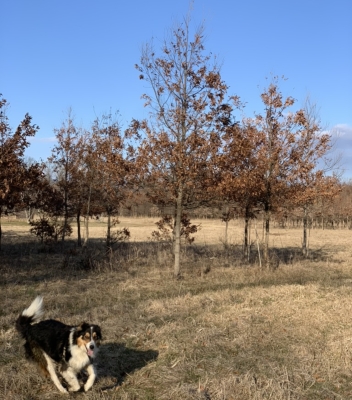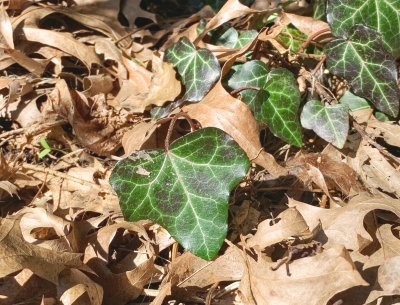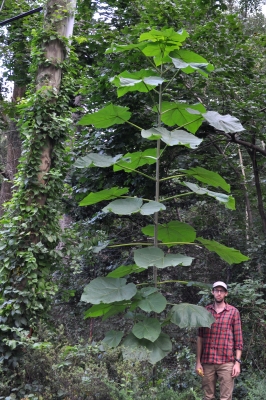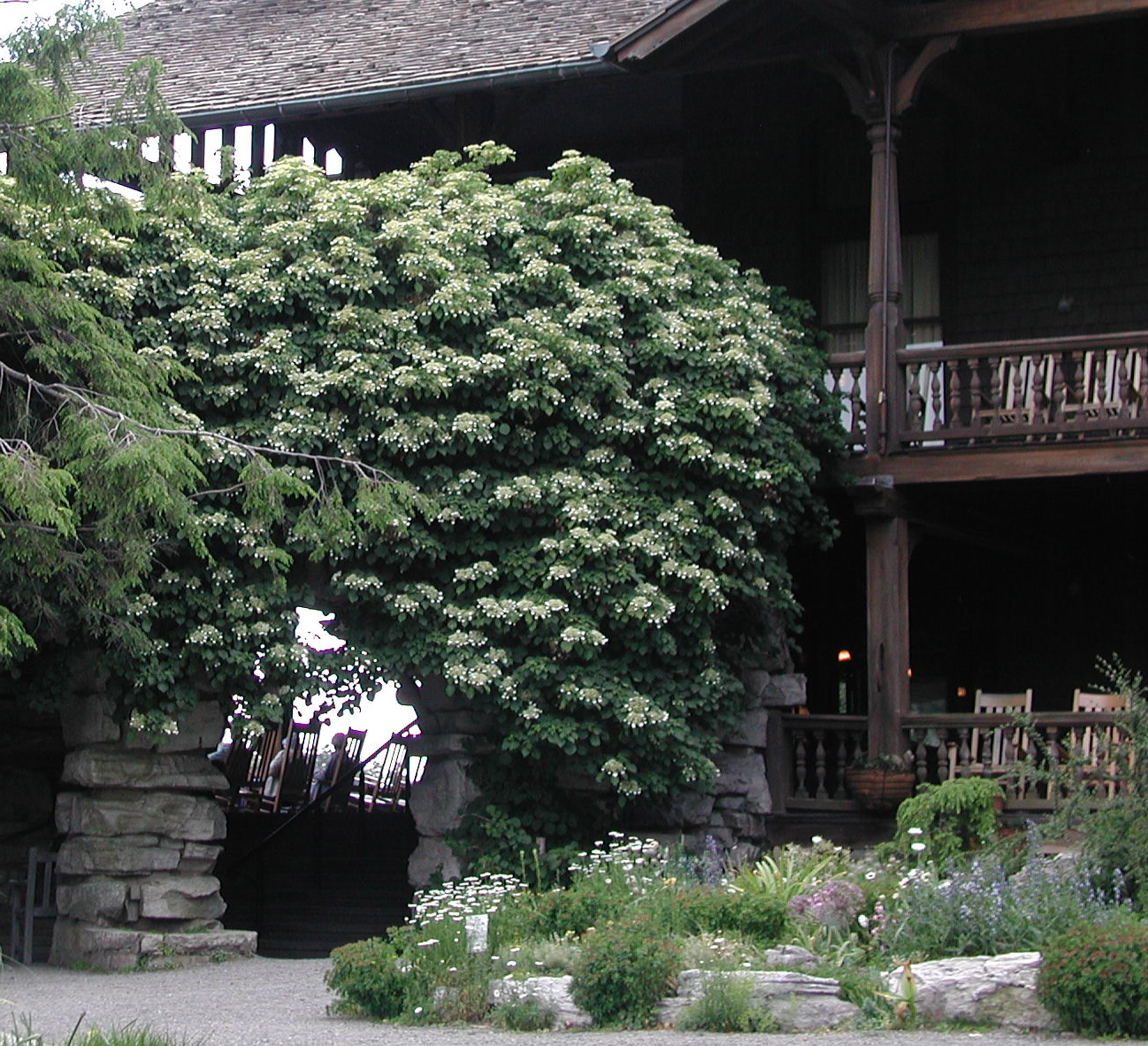BENEFITS OF IMMATURITY
Old Skirts
Looking at trees that usually drop their leaves in winter, you might notice that some of them — especially beeches and oaks — wear skirts of foliage all winter long. I say “skirts” because if the trees were human, the leaves would all be at skirt-level. Rather than being lush and green, these skirts are dried and brown or gray, just like their counterparts on the ground.
These trees, still clinging to their leaves, aren’t out of synch with the environment. Nor does this habit reflect the effect of climate change or nighttime lighting. The oak and beech branches cling to their leaves because the branches are “juvenile,” and reluctance to drop leaves is one sign of juvenility in plants.

Juvenile oak trees
(Artificial lighting and a warming climate have been shown, though, to delay leaf drop in autumn and advance the time when leaves unfold in spring, just how much depending on the tree species and the duration and the color of the light.)
Changes with Maturity
Juvenility in plants is akin to prepuberty in humans: during this period plants grow but are incapable of sexual reproduction, that is, flowering, then setting seed. The duration of juvenility varies from plant to plant. Radish seeds planted this spring will, a few weeks later, send up flower stalks if the roots aren’t harvested. Plant an apple seed and ten years or more might elapse before the tree first flowers.
Growing conditions influence the amount of time it takes a plant to reach sexual maturity. Wild plants on cold, windswept cliffs grow so slowly that they may still be juvenile after a century.
In a greenhouse, with supplemental artificial lighting, apple trees have been coaxed to flower within a couple of years. But no matter how much the scientists fiddled around with growing conditions, no apple plant would flower until its stem was at least 75 to 80 nodes long.
A juvenile plant not only doesn’t flower, but also may have a different form from a mature plant. My father had an English ivy plant that three decades of growth had changed from a creeping vine with lobed leaves, incapable of supporting itself, to a shrub with sturdy stems and rounded leaves — sure signs of maturity in this species.

Juvenile English ivy leaves
A horticulture professor of mine once described a gift he received of a “tree” English ivy plant, made by grafting a length of juvenile English ivy onto a robust length of trunk of mature English ivy; the juvenile portion grew vining stems that cascaded down from above the bare mature portion.
The Peter Pan Effect
Juvenile shoots also tend to hang onto their leaves, as is the case with those on beech and oak trees. Why, except when young, don’t these trees hang on to all, rather than just skirts, of leaves? The reason is because the whole tree isn’t juvenile, just the lower branches, which were there when the plant was juvenile. Juvenile portions of a plant always remain so, as do mature portions whether or not they choose to flower.
You’ll never see leafy skirts on any grafted trees, though. Grafting wood is usually taken from mature portions of a stock tree, so a grafted tree is always mature above the graft union. An apple worthy of propagation by grafting is deemed so only because its fruit has been sampled and deemed worthy. It fruited; hence, it’s mature.

Though still small, the portion above the graft, is mature and could fruit soon
Working with Juveniles and Oldsters
Does knowing about juvenility make me a better gardener?
Yes, when I propagate plants from cuttings. Juvenile shoots generally root more easily than do mature shoots. Juvenile shoots are those that originate near the base of a plant grown from a seed, or from a cutting made from a juvenile shoot. When I rooted cuttings of my father’s English ivy to make more plants, I made those cuttings from the still juvenile shoots growing near the base of his plant. Besides having rounded leaves and shrubby growth habit, mature portions of the plant are also easily discerned from juvenile shoots by bearing (toxic) fruit.
In most plant species, juvenile shoots grow more vigorously than do mature shoots, and have larger leaves. Juvenile sprouts on paulownia trees often grow fifteen feet in one season, with leaves more than a foot across, an effect that is decorative in the right setting. Lopping back all new growth each winter keeps the plant in perpetual youth with a decorative encore each year.

Large leaves and rampant sprouts of Paulownia near David (who is tall)
Lopping back is the pruning method sometimes used for maximum foliage effect from purple-leaved smoke bushes. No flowers develop, though, of course. You have to choose whether to let the plant mature to bear its smokey clusters of flowers, or whether you prefer smoke bush for its large bold leaves.
Knowing about juvenility also helps when I raise perennial flowers from seed. Perennials usually do not flower until their second season. But by sowing the seeds indoors in March and spurring the plants on with good growing conditions, they can make enough growth to mature and flower their first season.
Mature plants sometimes need just the opposite of the free and luxuriant growth needed by juvenile plants. My pear trees, for instance, although mature (because they are grafted), often are reluctant to flower and fruit. The way to induce a mature plant which is not flowering to do so is with “discipline.” In the case of my pear trees, I could slow down growth by scoring the bark with a knife or by pruning the roots with a spade.
My method of choice for the pears was to capitalize branch orientation’s effect on flowering and growth. Natural hormones within plants make vertical branches more vigorous and less fruitful than more horizontal branches.  I use strings to pull branches downward, but not quite to the horizontal. The trees also need to grow.
I use strings to pull branches downward, but not quite to the horizontal. The trees also need to grow.
(The above is adapted from my book The Ever Curious Gardener: Using a Little Natural Science for a Much Better Garden.)



Detecting sounds could be a step forward for agriculture, potentially offering a new way to monitor water stress in plants
https://www.sciencenews.org/article/plant-stress-ultrasonic-click-noise-sound
I had read about the research. Interesting, but not really surprising. After all, there’s bound to be some noise as cells expand or contract or dry out. As far as practical applications of these findings, I suppose it could be useful in a commercial operation, where optimizing production is needed. In my garden, I’ll probably always rely on looking at my plants, feeling the soil, and sliding my $15 electronic moisture meter (reasonably accurate) into the ground to assess moisture levels.
Beyond Oak and Beech. is it young ironwood or hophornbeam that also keeps it’s leaves through winter? I have assumed it is young beech and realize I am wrong. I am up in Catskill Ny. and i see it from hear to northern nj throughout the winter.
Ironwood is one of my favorite trees but I have to admit not noticing if juvenile parts of the tree retain their leaves. The trees don’t get very big and they grow in deep shade in forests here so they may lose their bottom stems — the juvenile parts of the plant –and not have a place on which to retain the leaves.